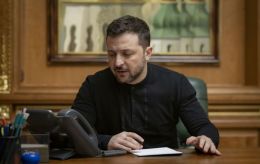US's confiscation of Russian assets hinges on consent of G7 and EU - AP
 President of the US, Joe Biden (photo: Getty Images)
President of the US, Joe Biden (photo: Getty Images)
The large aid package that President Joe Biden signed on Wednesday for Ukraine and other allies also allows his administration to confiscate Russian state assets and use them for the benefit of Ukraine. However, the US is unlikely to do so without the consent of other G7 members and the European Union, according to AP.
In the US, $5 billion of the Russian central bank's assets have been frozen.
Confiscations will be carried out under the provisions of the Economic Prosperity and Opportunities for Ukrainians Act, which was included in the bill to aid Ukraine.
The new law requires the US president and the Department of the Treasury to begin searching for Russian assets in the US within 90 days and report to Congress within 180 days. After that deadline, the president will be allowed to seize, confiscate, transfer, or transfer rights to any Russian state sovereign assets, including any interests, within US jurisdiction.
However, the US wants to continue consultations with global allies and act together, which is likely to slow down the process, according to the AP.
President's national security advisor Jake Sullivan said on Wednesday that this issue would be a major topic of discussion at the G7 leaders' meeting in Italy in June, adding that the ideal is for all of us to move together.
The law signed by Biden states that any efforts by the US to confiscate and reprofile Russian sovereign assets must be done in conjunction with international allies, including the G7, the 27 EU member states, and other countries as part of coordinated efforts.
Treasury Secretary Janet Yellen said the US is unlikely to act without the support of G7 allies.
Risks for the US
Critics of the law argue that using global finances against Russia could harm the reputation of the US dollar as the dominant global currency.
Confiscating Russian assets could lead countries like China - the largest holder of US Treasury obligations - to decide that keeping their reserves in US dollars is risky.
EU's stance
The US and its allies have frozen $300 billion of Russian foreign assets at the start of Russia's full-scale invasion of Ukraine.
However, finance ministers of the G7 countries meeting in Washington on April 17 failed to agree on how to use the frozen Russian assets.
The US supported the idea of fully confiscating the assets and transferring them to Ukraine. However, European officials are against it, fearing a violation of international law and destabilization of financial markets.
European Central Bank President Christine Lagarde said that the US proposals are causing serious concern among lawyers. "Confiscating Russian assets is something that needs to be looked at very carefully and could start breaking the international legal order," Lagarde said.
Resolution of the situation
Finance ministers of the G7 have agreed to continue working on possible options to be presented at the G7 leaders' meeting in Italy in June.
The European Union has already begun to set aside profits received from frozen assets of the Russian central bank. According to the bloc's estimates, the interest on these funds could provide approximately 3 billion euros annually.

